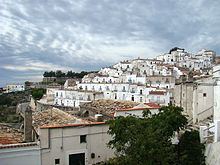Country Italy Comuni 61 Postal code 71100 Area 7,008 km² | Time zone CET (UTC+1) Telephone prefix 0881 Population 630,581 (1 Jan 2016) Area code 0881 | |
 | ||
Points of interest Gargano, Sanctuary of Monte Sant'Angelo, Troia Cathedral, Padre Pio Pilgrimage Church, Foresta Umbra Destinations Gargano National Park, Vieste, San Giovanni Rotondo, Isole Tremiti, Foggia | ||
The Province of Foggia (Italian: Provincia di Foggia) is a province in the Apulia (Puglia) region of southern Italy.
Contents
Map of Province of Foggia, Italy
This province is also known as Capitanata, originally Catapanata, because during the Middle Ages it was governed by a catepan, as part of the Catepanate of Italy. Its capital is the city of Foggia.
Geography
The province of Foggia can be divided in two parts: the one centered in its capital Foggia called Tavoliere and the other one that represents the spur of the boot-shaped Italian peninsula called Gargano.
The Tavoliere, a term that recalls the word tavolo, table, is so called because it is lowland and it is important for agriculture (grapefruit, olives, durum wheat, tomato). It is also called "the granary of Italy" because of its important production of wheat.
The Gargano is a peninsula partly mountainous and partly covered by a forest, Foresta Umbra with vegetation typical of Central Europe, the only lasting part in Italy of the ancient Black Forest. Allegedly its name comes from the word ombra (shadow) because of its thickness that prevents the light to enter in contrast with the typical flora. The coast of Gargano is rich in beaches and touristic facilities. In the north are two major salt lakes Lesina and Varano. It is also important for the production of olives, olive oil and both mountain and sea typical food products.
Population
It has an area of 7,190 square kilometres (2,780 sq mi) and a total population of 638,532 (2012). There are currently 64 comuni (singular: comune) in the province, see Comuni of the Province of Foggia. The number of comuni will be reduced to 61 in the year 2009 when three of its comuni, with a total population of 41,394 (2005 census) leave to form part of the new Province of Barletta-Andria-Trani. The three comuni, along with their 2005 census populations, are Margherita di Savoia (12,749), San Ferdinando di Puglia (14,457), and Trinitapoli (14,414). (The seven other comuni that will comprise the new province will come from the current Province of Bari.) The resulting loss would leave the remaining territory of the Province of Foggia with an adjusted population of 645,236 as of the 2005 census.
Population centers
Main centers in the province are:
Other centers of interest are:
Economy
Although less important than once before, the agricultural sector remains the mainstay of Foggia's economy, so much that its area is nicknamed the "granary of Italy". The few industries present are mostly devoted to food processing.
Almost every peeled tomato in Europe comes from the province of Foggia in southern Italy. Every year, two million tons of tomatoes are produced but the farmers get only eight cents per kilo. In order to survive in the free market economy most tomatoes-farmers recruit illegal immigrants.
Tourism
Foggia receives many Catholic pilgrims each year to locations such as the Sanctuary of Saint Michael the Archangel in Monte Sant'Angelo which was visited by Pope John Paul II in 1987 and to nearby San Giovanni Rotondo the home of Saint Pio of Pietrelcina from 1916 until his death in 1968.
